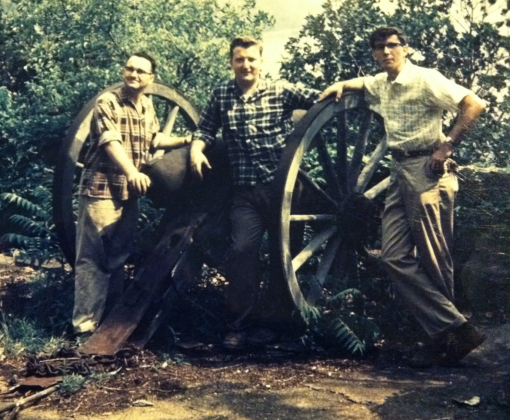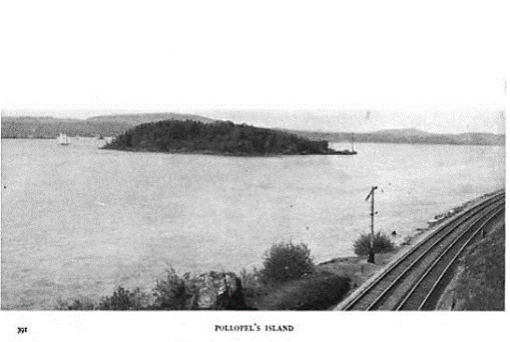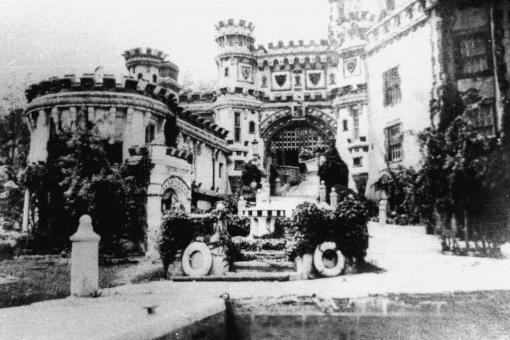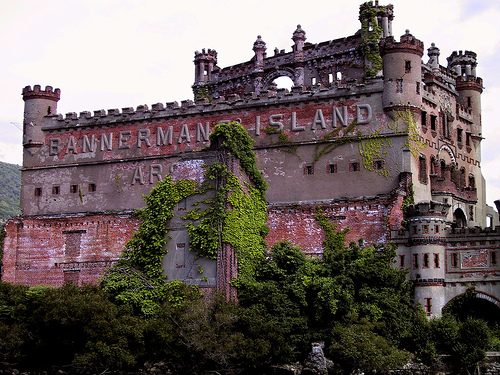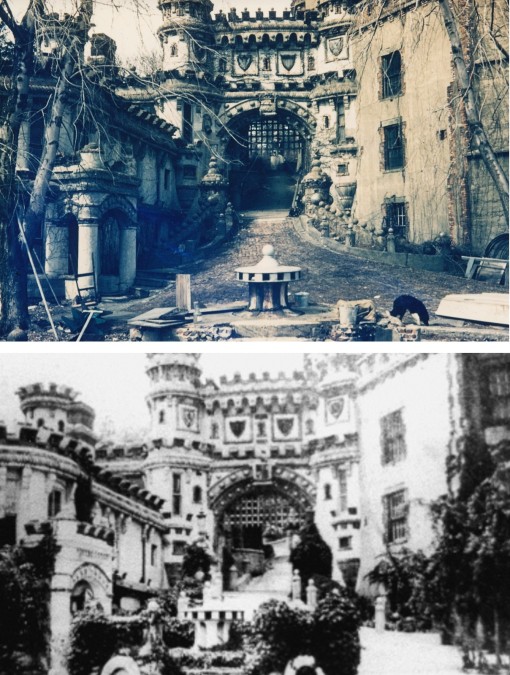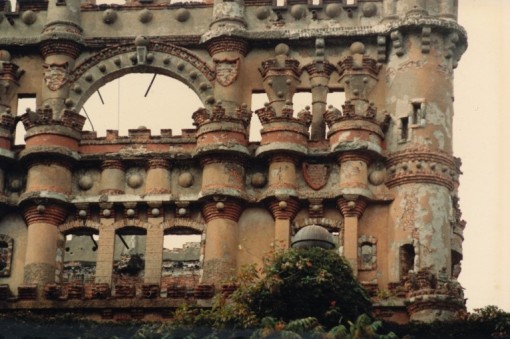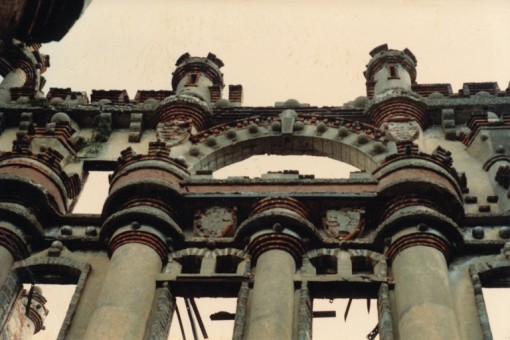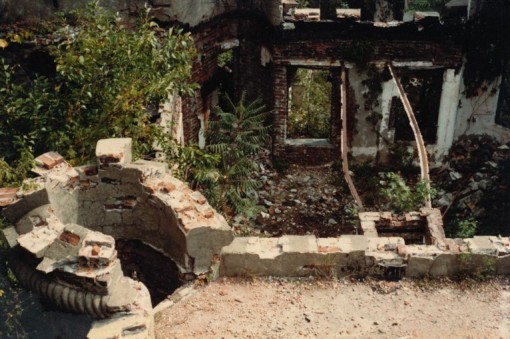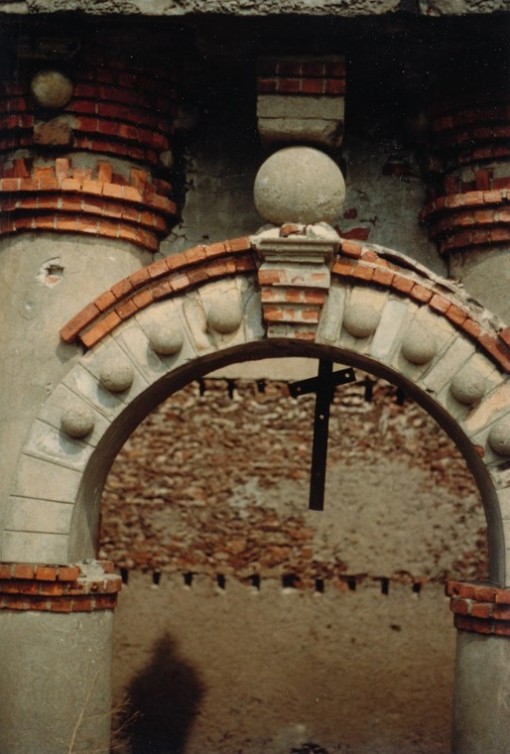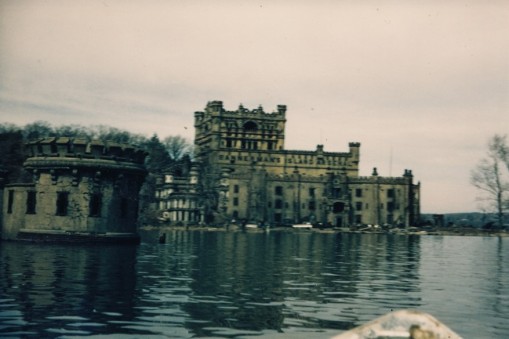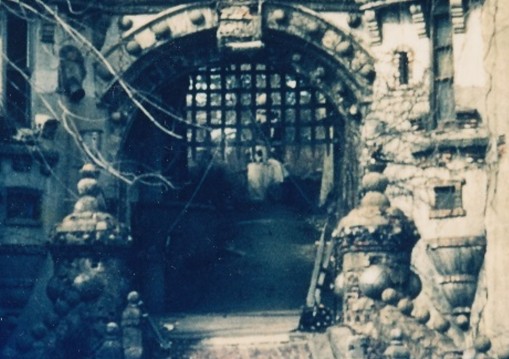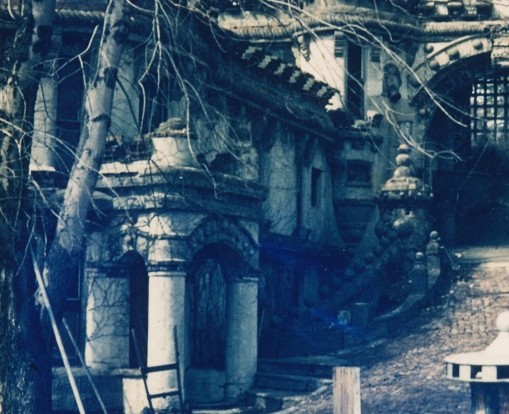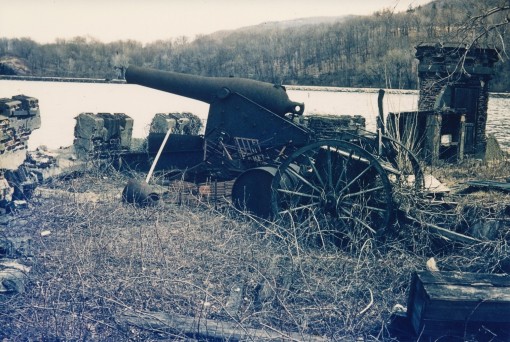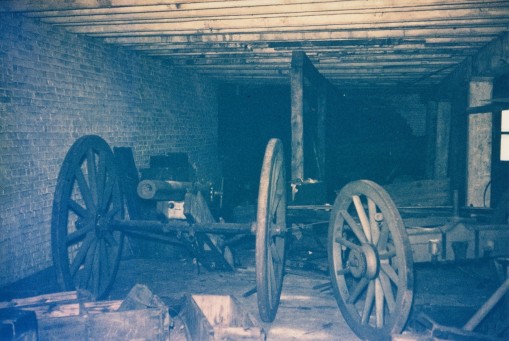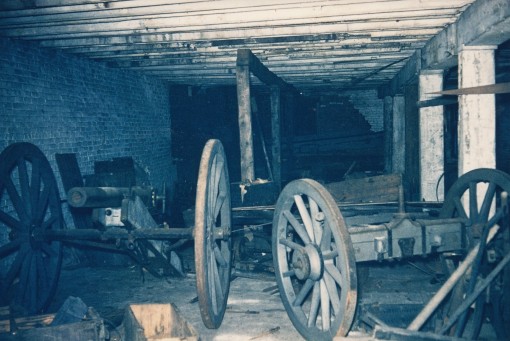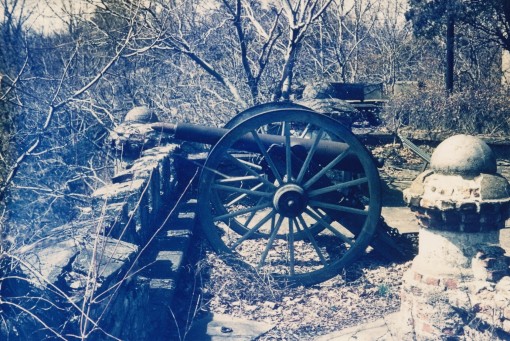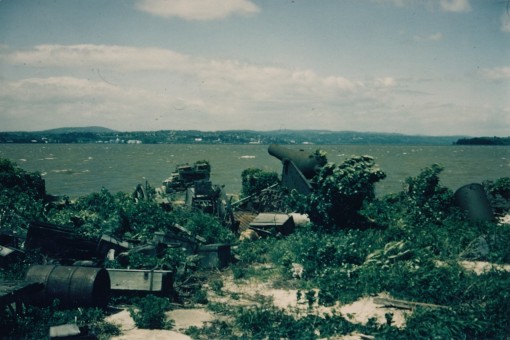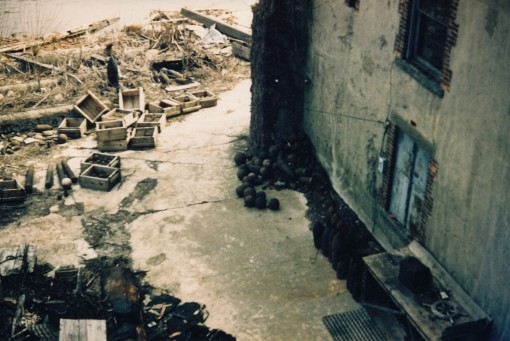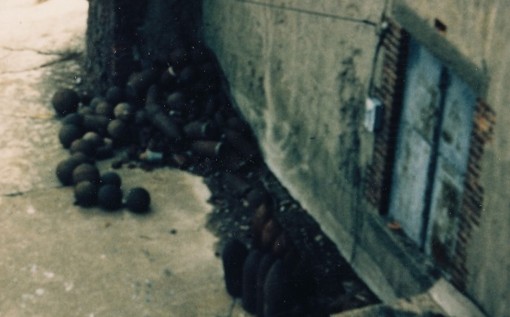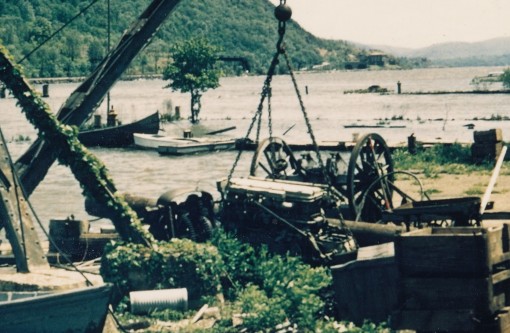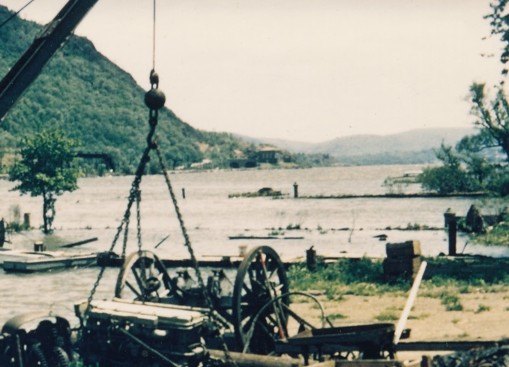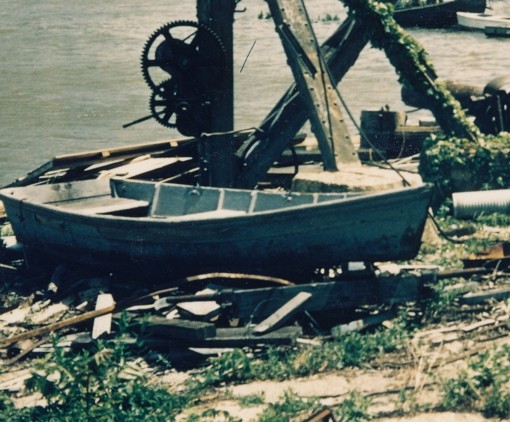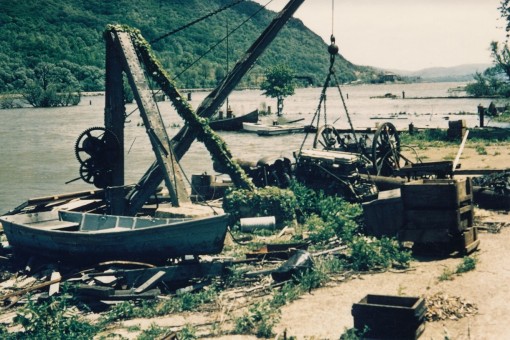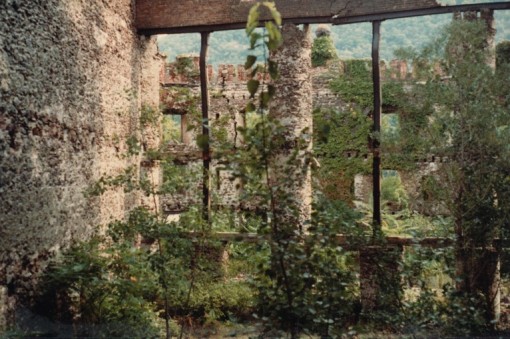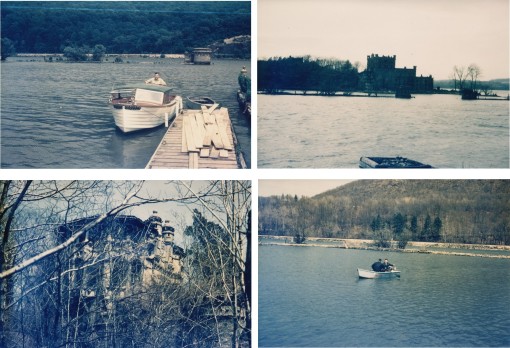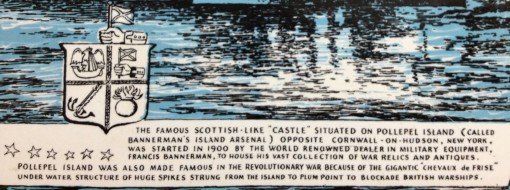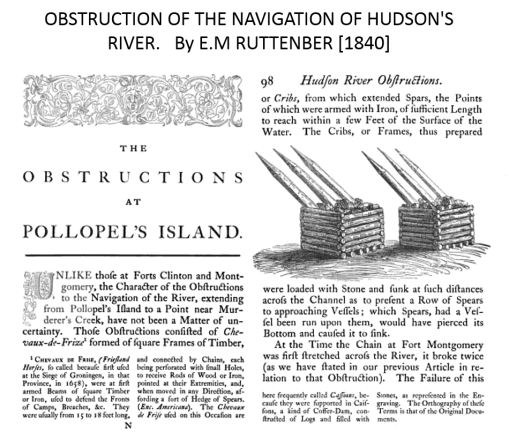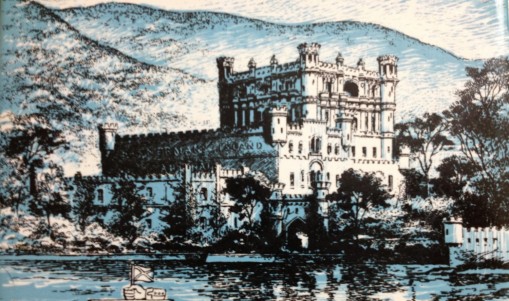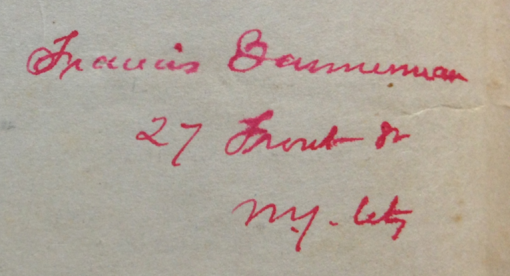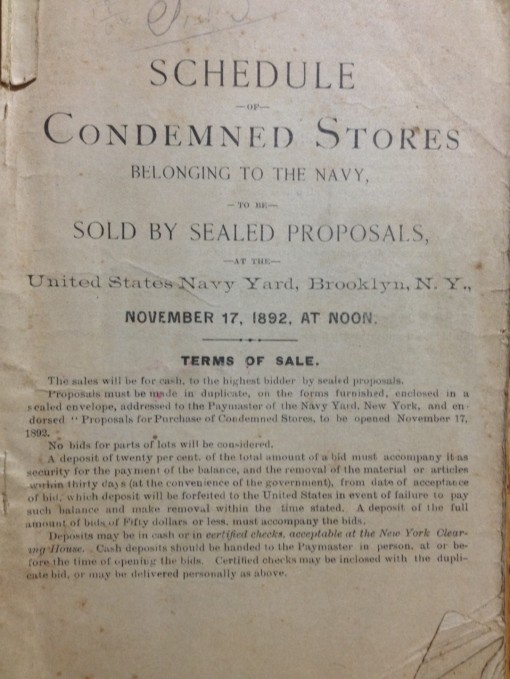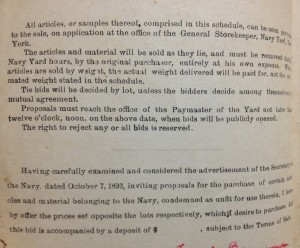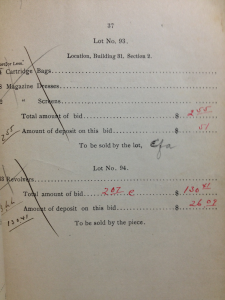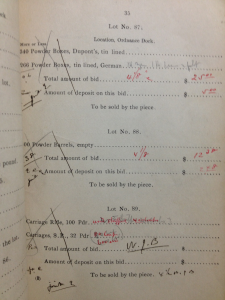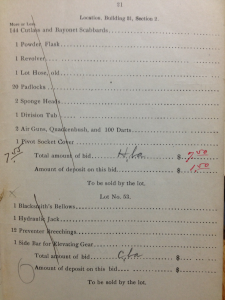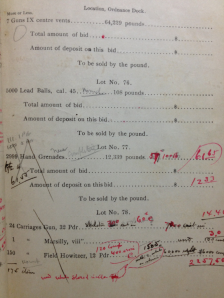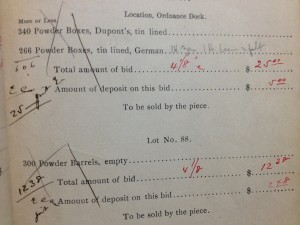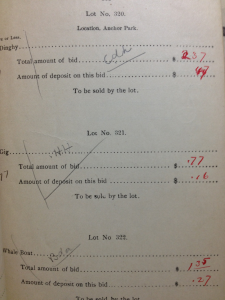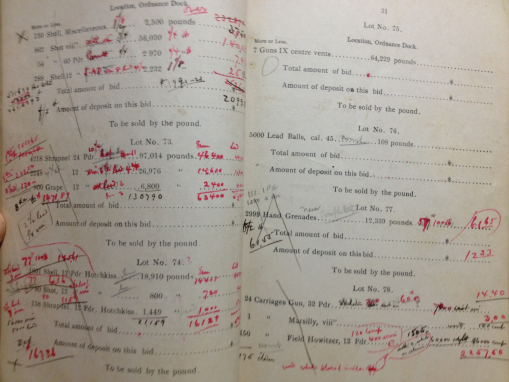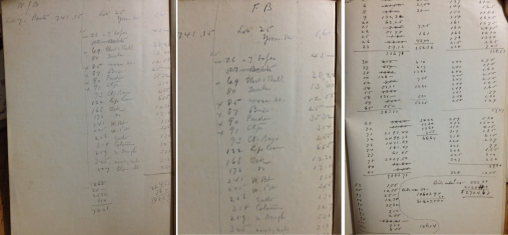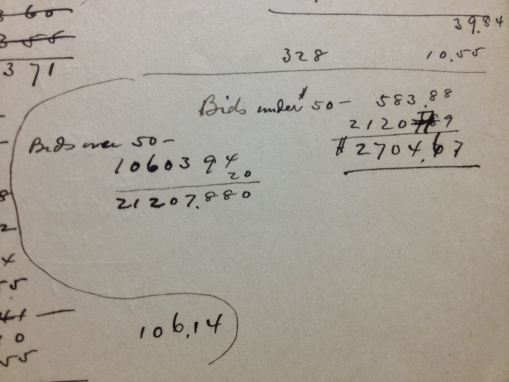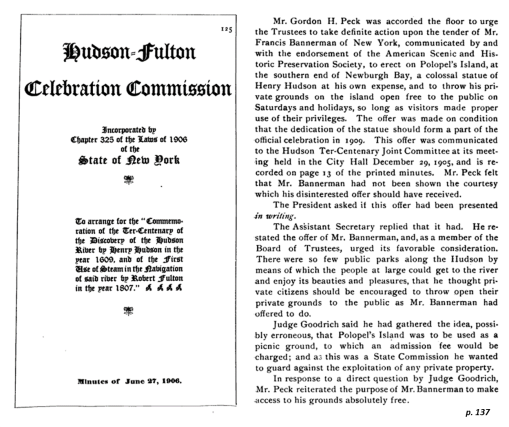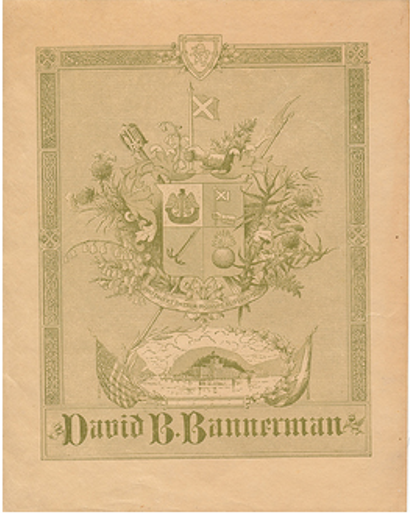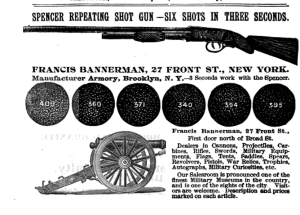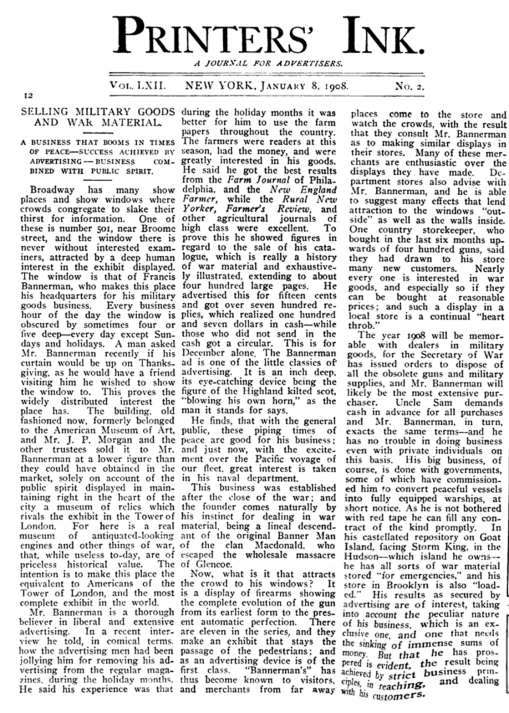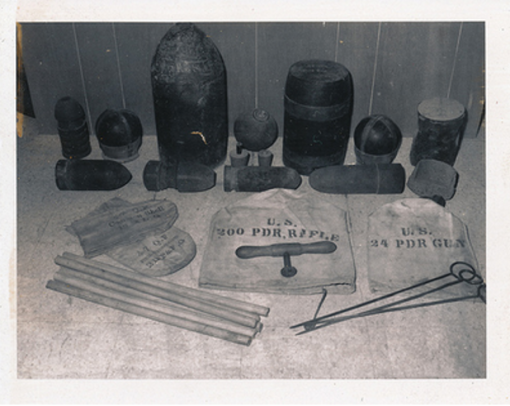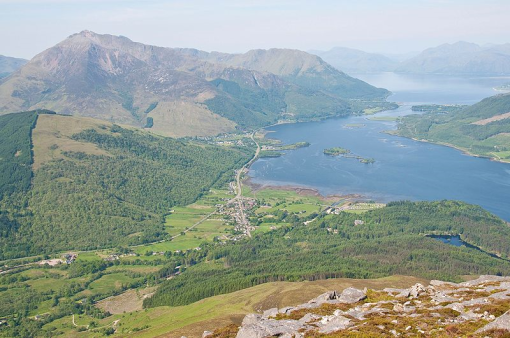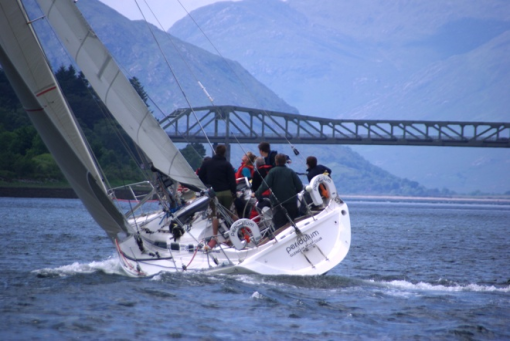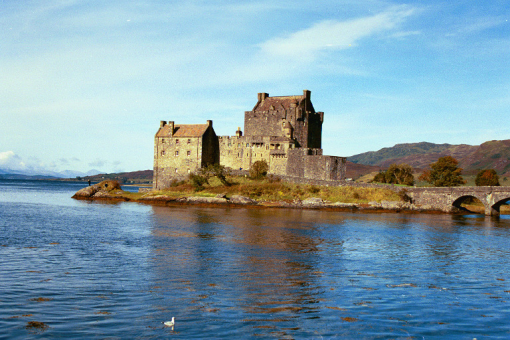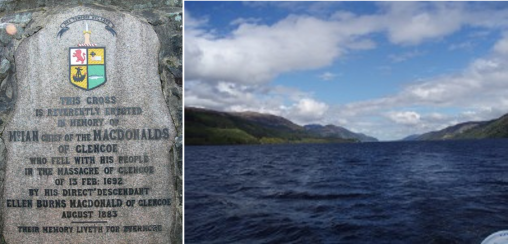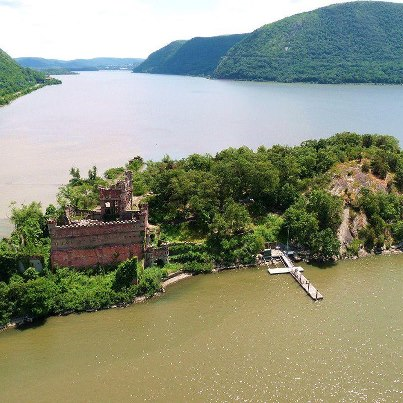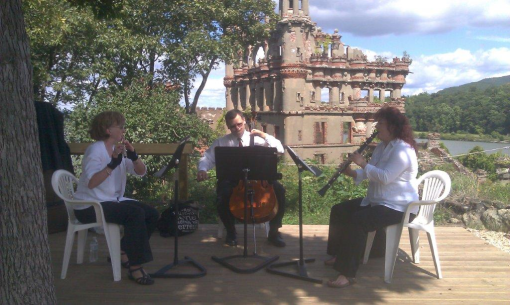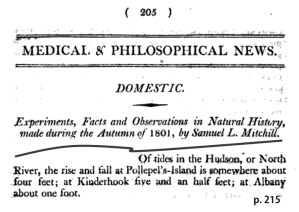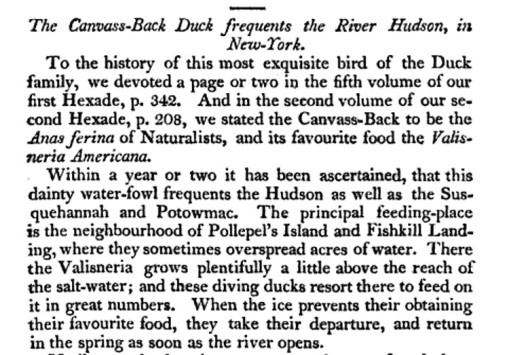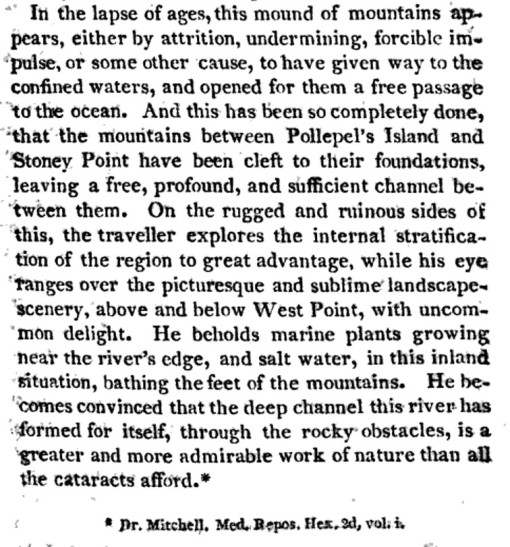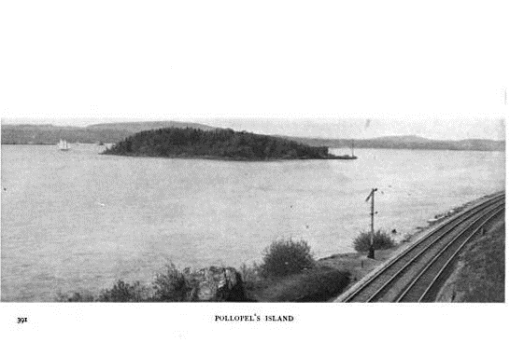My father, Ralph W. Altonen, is on the right with two of his friends (identities unknown).
Dad’s business partner Robert F. Pearson took these and the other pictures to be posted.
NEW SECTION !!!
Francis Bannerman’s signature in an 1892 Auction book for the Brooklyn Navy Yard, where Bannerman purchased a lot of his goods, found unexpectedly in my dad’s collection (July 15, 2013).
Many thanks goes to my Aunt Priscilla for giving me the pictures Uncle Bob and my dad took back around 1959-1960!
Source for picture: iridetheharlemline.com
Before the castle. From An Illustrated Guide of the Hudson River, Rand McNally, 1893
.
When we look at Bannerman’s Island today, what we see is an old covered in dense trees and an old castle composed of little more than just its walls, some old hints to its architecture, and piles of rocks barely discernible beneath the dense tree and shrub cover.
When I was a kid, I can recall seeing more of the castle, and was often told by my father about the few relics that may still remained on this island. These relics he told me were mostly from the Civil War and the years that immediately followed. They were the remaining supply of goods that were manufactured for use in this war, and could not be used once the war had ended.
Be sure to visit Bannermancastle.org
The original owner of this island and its holdings, Francis Bannerman, planned to sell these goods soon after the war was over. But due to various financial and legal problems, his business never really took off. He produced his first catalogue of these goods just a few years after the war. By the 1900s, larger catalogues were being printed by later vendors. In the 2010s I even managed to buy a few artifacts from this famous collection, sold in batches several times from one vendor to the next according to the individual on eBay selling these Irish military lapel pins from the Civil War.
Francis Bannerman
The stash he and my uncle once found on that island included large piles of unworn clothes, by now decaying due to mold and mildew. There were also thick leather belts worn by the cavalry during the war, waiting to rot, along with buttons, lapel pins, badges and other uniform or clothing related items of adornment. But the reason he knew about this place and had even visited he told was related to the numerous rifles, bayonets, cannon and artillery that once sat on that island, by then unused for nearly a century.
The picture that I had in my mind about this island during those years was that it was a cold, dark castle with a dungeon like appearance surrounded by damp stone walls covered with piles of rotting, decaying blue and grey clothing. By now, I was certain, this meant that the only things left to forage over there were more than likely just a few pieces of metal once sewn onto the clothes, belts and straps of any old army gear that could be dug up.
sources: grassrootsmotorsports.com (left), cover image for 1940 75th Anniversary catalogue (stretched 60% horizontally)
So where did all of these relics go?
It ends up, my father, my uncle Bob and a few of his friends were dealers who sold a certain amount of these relics. Just how much my dad was engaged in this venture I heard very little about, until my Uncle Bob brought it up to me sometime around 2002, when I was visiting him and his wife, my Aunt Priscilla.
My uncle Bob told me that during the 1950s, there was this post-war revival following World War II, in which military artifacts were again in high demand. To meet these demands he tells me he and my father filled out the paperwork needed to start their own personal business, engaging in this treasure hunt. In order to have access to these goods and sell them, you had to have a business and the official backing needed to become a seller of goods pulled from this island then in possession of the government. This is exactly what my father and uncle back then decided to do, and is how my pictures about this business venture of theirs came to be, along with numerous others taking advantage of these treasures for years to come.
Bannerman’s catalogue–cannons
I never really tried to make my way over to the island as a kid. The picture that is still in my mind was a place ridden with rats travelling between the piles of clothing they used for their nests. As per my childhood behaviors, everyone knew that I could manage the swamps, walking through inches of mud and come how with discolored socks. But rats instead of muskrats, now as then that’s a different story. At times, rats seemed pretty gross, riddled with disease, they traveled by the dozens, and were dangerous to people . . . including me according to mom. Thinking back on that, I realize such thinking was due mostly to New York City’s Mayor John Lindsay and his plan to eliminate rodents once and for all from all subway stations and tunnels. The ultimate goal was to clean up New York, and all of its ghetto buildings. I still bear the lapel pin for this social political movement–it reads “Starve a Rat Today!”
Today, one just doesn’t realize how rich in artifacts and official materials from the war that the island of Bannerman’s was. This is because you cannot see any evidence for such belongings. They were all removed to make the island “safer”, a large part of the reason my father and Uncle Bob were there.
“Bannerman’s Island Arsenal”
In the section that follows (still being prepared) are the pictures that my father Ralph Altonen and Uncle Bob Pearson took when they first set foot on the island sometime in the late 1950s. There are also pictures strewn about within about this island in it later days, sometime(s) in the 1960s. The dates of these pictures are better guessed at by our current local expert in this piece of local history [name?].
.
Following my Uncle Bob Pearson’s passing a few years ago (2012), these photos were graciously given to me by my aunt (his wife) Priscilla Pearson.
The Flickr site with these: http://www.flickr.com/photos/33819257@N03/sets/72157633426728562/
The NEW & The OLD for Comparison.
The Pearson-Altonen Photos Collection
(Contact box is open on this page: let me know if you want to see a close up of any section. I will try to rephotograph some of these pictures for more detailed closeups later.)
.
.
.
.
.
.
.
.
.
.
.
.
.
.
.
.
.
.
.
.
.
.
.
.
.
.
.
.
.
.
.
.
.
.
.
.
.
.
Pictures taken of a hotplate I recently found in Dad’s belongings
.
The Chevaux de Frise set up to pierce the bottoms of British ships. [Source]
.
.
.
.
.
Another recent discovery in my Dad’s Belongings
I was going through my father’s collection of items recently, which were found in the attic and basement of my step mom’s place, Kay Altonen. In this collection there was this catalog among one or two hundred pamphlets, along with antique gun guides, gun dealer’s guides, rifle repair instructions, etc. — it was a listing of the military goods to be sold in the Brooklyn Navy Yard in 1892.
Things did not click about what it was for quite a while. In fact, I had these items sitting before me for 3 or 4 months, taking pictures of other goods, one after another, with plans to post them on the web sometime down the line.
Then the other day, July 15th, while going through ‘”my stuff”‘ again to see what else needed to be photographed, I pulled out this catalog again.
.
.
Talk about the obvious . . .
Inside were 100+ pages mostly of items and where they were stored in the Navy Yard, with lines next to the list for you to place a note about your bid for particular items into. This extensive list of supplies with had these pencilled in notes. It didn’t become clear to me what these notes were until I came upon the page of wagon items, detailing the wagonbeds, wheels and such.
According to my dad’s pictures, there were wagons in the basement of Bannerman’s castle. I then thought that they fit the description of the wagons on this page.
Another minute or two of going through other items in the catalog, glancing at all the handwritten noted scribbled about in it detailing bids and final prices and such, and then finding this lose piece of paper with a long list of purchases — one handwriting style — one buyer — hundreds of goods. Next I tried to look for Francis Bannerman’s name, which was in the very front of this book of course, a place you’d skip because you were more interested in the content of the book, not its preface.
This is part of that front page with Bannerman’s Signature and address on it:
On another page there were totals calculated for how much was purchased that day–$21,207.88. Of course I had to look this up just like everything else I research . . . the Inflation Calculators on the internet placed this amount to be worth, as cash, about a half million dollars today.

.
All along I was thinking this was a collection of items sold to numerous other buyers, noted in a catalog kept by the Navy Yard, on Long Island, and quite far from Bannerman’s Island.
Instead this Auction book is Bannerman’s own notes about what he had just bought from the Navy Yard on November 17th, 1892 . . .
‘duh’ I was thinking . . .
these were some of the wares sold at Bannerman’s Castle!
I knew my father had struck up a relationship with one of Francis Bannerman’s relatives, who worked with the American Bureau of Shipping in New York City (a group I wrote articles for back in the late 1980s and early 1990s). After all, I have these bookplates from this member of the family, who used them for his belongings. These too I just uncovered from Dad’s collection a few weeks earlier.
(What a coincidence !!! ??? . . . wasn’t there an island ghost?)
.
The following are the photos I took of this item. I’ll add more . . .
The catalog is about 108 pages total; it needs to be scanned and a pdf made.
Only a few pictures are shown here of course.
.
.
.
.
.
“W.B.” and “F.B.” made bids
.
$23,911.55 in the year 1892 . . . worth $500,000 in cash today!
(More on this catalogue once I am done photographing it to make the pdf.)
.
.

According to the expert on this piece of American history, Wes, it ends up there are plenty of documents detailing Bannerman’s purchasing habits. The largest collection is stored in a castle down south: about 40 boxes of family papers, still full of unsiphoned materials requiring extensive review if we are ever to more fully understand Banner’s true life story.
I spent some time reviewing the electronic materials–which I am still searching and reviewing–and managed to come up with a number of items that give me insight into Bannerman’s personal and business goals, habits, wants and needs.
Francis Bannerman, being the fifth “Jr.” with such a name now down the lines of descendants from the famous Macdonald Clan of the Highlands in Scotland, was naturally attracted to what the Valley offered to him (more on this “magnetic attraction’ in the next section).
Francis had the papers and connections needed to initiate his Island adventure. His fascination with the military wares must have had some personal reasoning as well. The reason that stands out to me the most, looking through all the items wrote about him and his personal behaviors and activities, is that Francis was very much a patriot residing in two countries. He had devotion to his Scottish heritage, with a drive for the economically driven American culture. His heritage gave him some high-up rankings perhaps, though not as much as a Livingston. But the symbolism oriented patriot side of him was focused on the United States.
Bannerman projected this part of his philosophy in several ways. The most symbolic perhaps is his desire to enhance the celebrations planned for the 300th year after Henry Hudson’s historical trip up the Hudson River in 1609, merged with the one hundred years celebration of Robert Fulton’s travel of the same river by way of this steam boat invention (there is evidence for others before him according to American Bureau of Shipping’s chief editor Joseph Evangelista).
(Any anti-Columbian Historians who read this, of course, just experienced a tremendous sigh of relief. Not sure how I would take that Colossus of Rhodes approach to Polopel’s Island in my childhood years.) It was then just 26 years after the Statue of Liberty project.)
One of the aspects of Bannerman’s personal philosophy with his combined patriotism-nationalist attitude is his belief system, more than likely a consequence of the National Rifle Association. The NRA as formed on November 17, 1871. Its first members and officers were pretty much Civil War vets. The Civil War provided the country with the first very large supply of leftovers from a War of multiple disciplines and multiple cultural content. Ironically, there were often missing supplies during the Union War. Once the war was over, there were now too much for the government to keep. Storage space, lack of use, and the likelihood that the newest in products would soon be replaced by newer inventions, made the possibility of storing goods other than artillery supplies such as gunpowder an unwanted venture. Being the patriot that he was, Bannerman had the answer to this. . . become an antique military goods supplier.
It would be an understatement to claim that grew up knowing about the Second Amendment and the Right to Bear Arms. I remember first learning this in Fishkill, New York, a place where the teachers could impress upon you the importance of local history on the outcome for the American Revolution. Fishkill is where the George Washington had a camp set up, where his sword was forged just down the road at a smithers’ place off of Main Street, where the soldiers stayed just south of the village, and where soldiers were brought to after the Battle of White Plains. I grew up in a house where the walls were decorated by symbols of the Second Amendment and our right to bear arms.
In my house, there were what looked like Bucklin’s Musket pistol sitting on the wall, framed but removable and highly functional if you had wire cutters and some balls and powder to spare. There were also these bayonets resting in the corner of the living room, a framed copy of the constitution on old linen style paper, a big lithograph of Ulysses S. Grant, a smaller portrait of his opposition Robert. We had a couch-long knee-high table made from hand-cut lumber stored in a 18th century farm then standing in Stone Ridge. On the floor, an approximately 3 feet high Howitzer shell with the traditional souvenir cap was used to store maps.
Map Storage and “door weight”, with shotgun shell for size comparisons
The rooms downstairs were the equivalent of the arsenals we hear about in contemporary homes out in the Dakotas, where very local government are mostly in control, not any Towns or Federal offices with all of their restrictions.
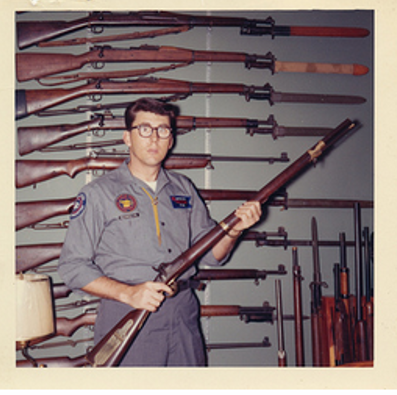 Dad in the first version of his “Office”
Dad in the first version of his “Office”
Dad’s office, a few years later new paneling was added to hold the “wall hangings”
.
My father came to know about Francis Bannerman through his son (or grandson?) David Bannerman. David Bannerman at the time worked for the American Bureau of Shipping, and was world renowned, traveling about the globe dealing with international laws and shipping. Exactly how my father got to know David B. is uncertain, but I can be certain he knew him . . . going through his legal belongings and written documents — the evidence for this relationship with David is undeniable.
David Bannerman’s Bookplate with the family crest, from a collection of 6 of these, and the auction book already covered, all in Dad’s collection.
(None of these relics by the way will ever be for sale.)
Reflecting back on all of this, and from personal research experience with Scotsman and New York’s Lt.-Governor Cadwallader Colden, I suspect that the Scottish side of Francis Bannerman we can see by noting where it was that he wished to live, and the kind of air he wished to have about him whilst marketing military goods as best he could. Bannerman sold both working and non-working military hardware, not just antique military and non-military goods. For Bannerman, these goods were symbolic of the meaning of his right to have, bear and at times use arms to the fullest intent. Bannerman’s antique firearms were collectible, but they also worked. For me, Bannerman’s behavior with his cannons seemed to elude to this part of his persona quite a bit.
I can remember one day sitting in my back yard, and others at the firing ground at the local country club, watching as we loaded the 1.5-2″ diameter bore cannon for July 4th. We fired it into the woods, or into the hillside or down the firing range.
Francis Bannerman had much this same view on his firearms, and people rights to own and use them. According to historian Wes, Francis saluted the passing of boats, greeting them with his cannons on the shoreline. He used them to celebrate July 4th, like any well armed patriot should. He’d fire a shot, leadless, shell-less, and ball-less or not, in the most appropriate directions. One of these times he “missed” Wes tells me, and blew out the wall of his “neighbor’s” barn located a quarter of a mile away on the mainland.
[]
There is more to owning weapons and artillery than just having them “to bring the kid out in us”, at least as the 40s, 50s, 60s and early 70s portrayed men as behaving like “kids.” In one article published about this part of Bannerman’s personality, we cannot miss that traditional nationalistic viewpoint he had about life and government in general.
.
Let’s not forget, being an “upstater”, non-NYC-urbanite like many others probably reading this page, we locals do have this paranoia about city-spenders. We react negatively to the idea of investing in local property for the sake of the money, but not the community. Was this was Bannerman was doing? Probably not. The island does have its local cultural values, and Bannerman was a businessman, like other upstate businessmen for his time. To be successful, he had to merge the two somehow, which he did. Although no statue of Henry Hudson was ever erected onto his island, its availability for such a use remained a common option for a while.
[]
From the newspaper and legal documents we know that Francis Bannerman was a building and blockowner in New York, who managed business and tenement setting, who at times had to expel his renters for all the standard reasons that exist, poverty being one of them. But he was interested in using this income source in that more traditional, devotion to culture and patriotic way. Francis Bannerman used his earning to buy the left over ammunition and various supplies remaining from the Civil War, and other battles that ensued, to develop his line of business in selling antique military goods.
There are two avenues he took with this enterprise. The traditional was designed to get rid of antique Civil War stuff, some of which is still circulating about on the internet by third and fourth generations sellers by way of eBay. A more contemporary use of old, aged artillery and military goods was also a part of this business.
True Military “Antiques” owned by Bannerman
In 1890, the previous wars now over, and the need for old military wares minimized due to the peace at hand, he bought many of the belongings left over at the military and naval storage stations on Long Island, and later in the Far West in places like the Rock Island storage facilities on the Mississippi River at the western edge of Illinois.
Even though they were termed recent, they still worked. Bannerman benefited from this fact about guns. Made of metal, and being totally mechanical in nature, when bought, preserved, fixed up and at times repaired, they worked then just as good as back when they were new, just 5 to 20 years earlier. On one occasion, Bannerman took advantage of this fact about metal firearms. With the threats of World War I around the corner, the military needed some of their old cannons back. Francis Bannerman sold them back of course, but at a profit–a two-thousand fold profit in fact. The military of course wasn’t very happy at all about this. This led to the governmental process involved with taking Bannerman to court, for greed and monopolization of rare and important goods, if nothing else. The large cannons of recent past, considered outdated by the military itself, had to be bought back by these same judges of their outdated technology and physical power. This “power”, although light, was needed nevertheless. Afterwards, Woodrow Wilson had to deal with such a limitation of US power in the first word war, thus the cause for Bannerman’s court display.
Like any fan and expert of the military, past and present, Bannerman was as much into play as he was into war. In the case of play, he favored outdoor recreation. Outdoor recreation and war meld together quite well when it comes to the tool of hunting–the weapon–of the tools of camping and protection from nature’s risks to life–good shelter, clothing, hunting and butchering knives, transportation goods, archery supplies and weapons, and of course guns and cannons. Well, maybe cannons and the cross-bow were going a bit too much into this. And to fire a Turkish blunderbust in the woods did more to save your life from a bear, than to supply you your next waterfowl dinner. Even a salt-loaded shotgum offered you more protection in the woods than it provided you with any edible, tasty bird and small mammalian meats.
[]
The outdoor journals benefited Francis Bannerman quite a bit, and he was a benefit to them as well–for this is where he had his numerous advertisements posted about the military wares he had for sale.
[ads]
The magazines that Francis Bannerman advertised in are as follows:
[]
The advertisement by Bannerman also fit the consumer he was targeting–he had ads meant for collectors, others for hunters, others for outdoor recreationist families with kids, others into the power of the gun or their readers’ masculine virtues. Bannerman at least had a multilevel marketing procedure in place.
Some of the more interesting articles for Bannerman’s work and history pertain to the history. The single most interesting article to myself is the article devoted to the history of war, weapons and firearms.
Some possible Island wares
(Note: extend this to the other pictures as well — for some items displayed in my photos, I am not sure which came from Bannermans’s)
.
.
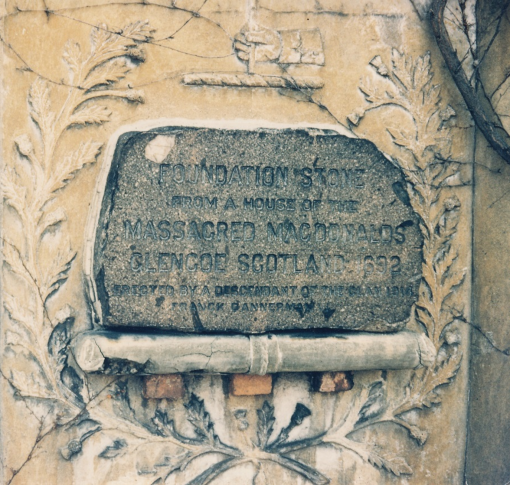
One of the things I do when I study a historically important person like Francis Bannerman is try to “read” into his personality. Francis Banner had much to say about his family’s history. His inclusion of the Macdonald’s Foundation Stone in his castle tells us he had a significant amount of respect for this particular Scotch lineage.
But there are two other things about Bannerman’s Castle that are important to note. Francis lived this portion of the Hudson River for much the same reason as a previous Scotsman travelled through this region and finally settled.
When New York’s Scotsman Governor Cadwallader Colden made his way through the region, it reminded him as well of homelands in Edinburgh, Scotland. After surveying much of New York State for the King of England, Colden later laid claim to land in what is now the Newburgh area. The town of Coldenham in fact is names after this piece of local history.
To Francis Bannerman, any trips he may have engaged in along the river during his earlier years, by boat, train or even by horse, would have exposed him to the same sense of place for a Scotsman. We can tell this was the case when we take a look at the pictures of the part of Scotland where the Glencoe massacre took place. To Bannerman, the memory of the Macdonald Clan that once resided resided there was here to stay–and so he planted that memory into his castle by dedicating it with this very historically important cornerstone. Bannerman brought Glencoe to New York one could say, making such a stay permanent by building his now famous castle.
To me, I can understand this way of looking at things. The following pictures illustrate just how much like this part of the Hudson River resembles the old home towns in and around Glencoe, Scotland.
Another way to put this is as follows . . . pretend for a moment that you didn’t read these paragraphs above and then ask yourself,
.
‘Don’t these places look like they could be a part of the Hudson Valley or be located on the Hudson River?’
.
That part of the Hudson looking south, just below Fishkill, towards Storm King Mountain . . . greatly resembles this picture from http://en.wikipedia.org/wiki/Glencoe,_Scotland
.
.
source: http://www.clansmithsociety.org/Debbie%20and%20Mike%202003%20Scottish%20Tour%201.htm
.
source: http://i50.photobucket.com/albums/f310/alexglass/Glencoe/TheGlencoeMassacreMemorial6.jpg
Tales of the Glencoe Massacre are at:
http://www.ourscotland.co.uk/phpBB/viewtopic.php?f=4&t=1567
http://en.wikipedia.org/wiki/Massacre_of_Glencoe
http://www.thesonsofscotland.co.uk/themassacreofglencoe1692.htm
http://www.youtube.com/watch?v=vDUcIN4hwMk (video)
……………………………………………
Pollopel/Bannerman’s Island Legends
.
Before there were castles, there were these local legends associated with this part of the Hudson River. Two of these legends are ancient, meaning they were there when the Native Americans were living in his part of the valley. One of these legends, and a third legend of this part of the river, have European roots that can be traced as well. The ancient legends pertain to the uses of landforms unique to this setting. The high elevation and prominence of certain hilltop setting made them prone to serving as legendary Indian burial grounds. One or two of these overlook the Hudson River in the Highlands area, and of course there are more sites capable of overlooking to river. The cliff known as Breakneck is linked to the second legend of Indian origin, in which an Indian “Princess” falls to her death here due to a suicide engaged in after the death of her great lover. This legend may be Indian in nature, it may not be.
It is no coincidence perhaps that a similar legend forms the background story for many a storyteller talking about Bash Bish Falls located at the western edge of Massachusetts, just east of the state line depicting the edge of New York. An “Indian Princess” also took her life there for much the same reason. Such a tale would make for great tourism in the early 19th century, when horse and wagon, then stage coach, then sloop, steam engine and finally coal powered locomotives became the way to travel into the backwoods if an gas-powered vehicle known as an overlander wasn’t in your possession or at hand.
The second batch of folklores, legends, myths, beliefs about this part of the Hudson River is found in writing as early as Jasper Danckaerts’ writings about his trip up the river in the late 1600s. A religious utopian who was in search in the next Garden of Eden in the New World, he speaks of the Dancing Chamber where the winds would pick up and blow your ship about by its sails, being stretched in one direction and then the next, and at times in circles with such violence borne by its winds that if you weren’t careful, a mast could come down or sail bearing rig turn about and strike you in the head. Many lives would in the future be lost this exact way in the century or more to come. This naturally-defined fate of death was what made Madame Curie a widow with a large lot of land to make use of, and it was what took the lives of later social and political leaders as well at times.
This particular feat of nature had attached to it some prominent German attitudes about its making as well. This natural force guided you, directed you and prevented you from making you way north to south, east to west, south of the Fishkill Landing, with its natural barrier formed just north of the most dominant ridge of the Highlands. North of Polopel you no long had to suffer the consequences of sailing in and through these vortices. South of Polopel, it was up to God and Nature to decide you life’s fate. This natural born “monstor” of nature’s forces and nature powers [] later help give rise to many of Washington Irving’s ventures into writing about such unbelievable follies of nature. We it not for their frequency, their effectiveness in scaring us and on occasion taking lives, their coincidences with other natural events like the active thunderhead giving us the sound of a heavy ball rolling, discharging light into the sky as it was laid upon the ground’s surface, followed by the rich and various sounds produced once it struck a set of Dutch made pins, we would not at all believe Irving’s popular culture derived claims that there even existed this monstrous force in nature, this German character of nature’s evils, desires for evil, vengeance and death, as portrayed by all of the ways in which nature can without a doubt take out lives in the Hudson Valley. No painting was ever needed to prove to you that such a natural force existed when you lived in the Valley region. Those realistic paintings of the Hudson Valley painters, all they did, was reinforce the socially accepted fears of fate to the natural threats that lie around us all of the time while residing in the Valley. Englishmen and Dutchmen lost their imagination as they removed the trees that formed their dark, dense forests. Hudson Valley residents had that gift of nature handed back to them, and no matter how quickly we tried to convert the Valley from virgin wilderness into pastoral lands, we couldn’t remove the powers of Nature and God from this scenario. The oldest philosophies of the lands that surround Polopel’s Island and Bannerman’s Castle were bred and raised due to such ways of thinking. What were myths and legends, true or not in terms of their Native American heritage, were ideas that naturally fit the philosophies of the Valley’s future residents north and south of the Highlands. Many other future philosophies would be born from this soon to be highly inbred local belief system (multiple meanings intentional) that separated the local families, Native and Anglican-Dutch or not, from the non-locals. Today’s haunted house is a natural result of these belief systems passed on from one generation to the next. Today’s Bannerman’s Castle is bred by much the same beliefs, giving arise to ideas, then ghosts, then spirits, then natural powers, whatever was needed to keep the stories of this region alive. Any modern day “ghosts” or “energy clouds” of Bannerman’s Island and castle must have genealogic links to the Great Spirits of the past, the Iroquois Manitou or the Wappingi’s and Mahican’s counterparts, the Indian Princesses from near and afar in the county, or even the Headless Horseman and Filipse Lady riding on horseback through this valley region. All of these form their own part of the same story.
In this section, the following examples exemplify some of these stories.
[inserts]
.
.
Friends of Fahnestock and Hudson photograph.
Fortunately, this island can once again be visited.
For more on Visiting and Tour information, see:
Newburgh NY Cruise and Walking Tour
.
Source: Bannermancastle.org
.
TO SHOW SUPPORT for the rejuvenation of this site and stabilization of its historical architecture, please visit:
http://bannermancastle.org/ (for Bannerman Castle Trust Inc. donations)
http://www.facebook.com/BannermanCastleTrust
http://www.facebook.com/BannermanIsland
.
Other places to visit with information on the history of this site:
Rob Yasinac’s Hudson Valley Ruins Page
Linda T. Hubbard’s Bannerman’s Island Photos.
Liz Robbins’ New York Times article on this site
Xydexx’s Exploring and Modern Ruins page
Kuriosita’s Page (with exceptional, large photos).
BLDGBLOG Architectural Conjecture site
Huffington Post: preserving the ruins
.
Historical Notes
.
For history buffs like myself, the following are early mention of this place in the literature . . .
. . . rediscovered thanks to Google Books (the titles have links).
.
A Famous Revolutionary War Event for the Region. (see 4th paragraph Oct. 23rd entry)
The Scots Magazine, Jan 1778 vol. 40, p. 16
.
First Mention in US Magazine? (author Samuel Mitchell)
Medical Repository of Original Essays and Intelligence …, (1805), Volume 5
.
A Role in the Local Natural History.
The Medical Repository, Volume 4 (1807), p. 407
.
.
.
Its Fame in Germany due to Mitchell and pp. 176-177 of James Mease’s 1807 book A geological account of the United States: comprehending a short description of their animal, vegetable and mineral productions.
.
Source of above: Neue Jarbücher der Berg- und Hüttenkunde, Volume 2 (1812)
.
Its Naming History.
Egbert Benson, New-York Historical Society. Memoir read before the Historical Society of the State of New-York, December 31, 1816. 2ed with notes. Jamaica, 1825. Pp. 66-67.
.
More on its role in Natural History.
The Minerva, or, Literary, entertaining, and scientific journal, Volume 1, 1824, p. 313
WORK IN PROGRESS
